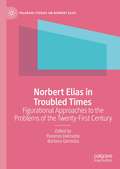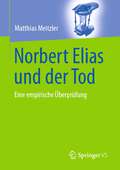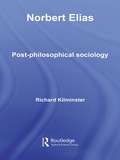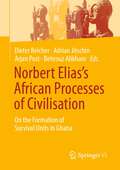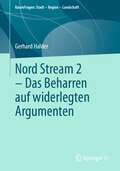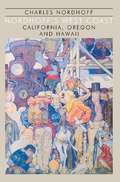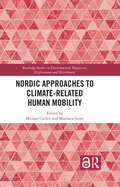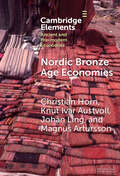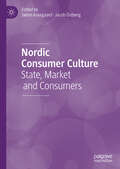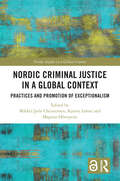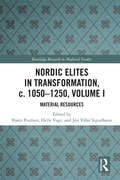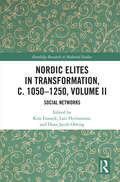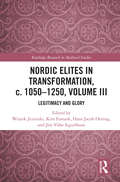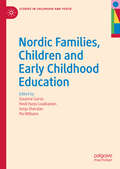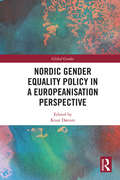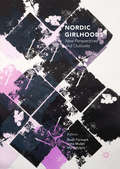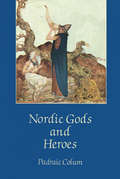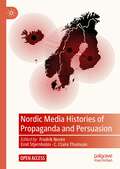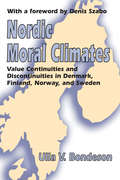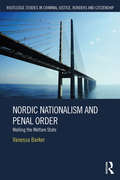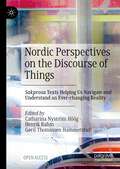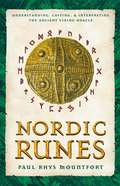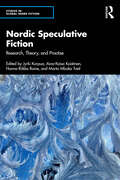- Table View
- List View
Norbert Elias in Troubled Times: Figurational Approaches to the Problems of the Twenty-First Century (Palgrave Studies on Norbert Elias)
by Barbara Górnicka Florence DelmotteThis edited collection brings together texts that discuss current major issues in our troubled times through the lens of Norbert Elias’s sociology. It sheds light on both the contemporary world and some of Elias’s most controversial concepts. Through examination of the ‘current affairs’, political and social contemporary changes, the authors in this collection present new and challenging ways of understanding these social processes and figurations. Ultimately, the objective of the book is to embrace and utilise some of the more polemical aspects of Elias’s legacy, such as the exploration of decivilizing processes, decivilizing spurts, and dys-civilization. It investigates to what extent Elias’s sociological analyses are still applicable in our studies of the developments that mark our troubled times. It does so through both global and local lenses, theoretically and empirically, and above all, by connecting past, present, and possible futures of all human societies.
Norbert Elias und der Tod: Eine empirische Überprüfung
by Matthias MeitzlerDer Einfluss von Norbert Elias als soziologischer Klassiker ist unbestritten. Dieser Status verdankt sich in erster Linie seiner Theorie vom Zivilisationsprozess. In dessen Geist steht auch Elias‘ 1982 erschienenes und in mehrere Sprachen übersetztes Buch Über die Einsamkeit der Sterbenden in unseren Tagen. Dort widmet er sich der Frage, wie Menschen der Endlichkeit des Lebens gegenüberstehen, unter welchen Bedingungen sie sterben, sich voneinander verabschieden, umeinander trauern und sich aneinander erinnern. Im Zentrum steht die Einsicht, dass es immerzu die Lebenden sind, die das Sterblichkeitsproblem zu bewältigen haben. Menschen in zivilisierten Gesellschaften tun dies Elias zufolge, indem sie Sterben und Tod verdrängen. Als schambesetztes Thema werde das Lebensende in alltäglichen Gesprächssituationen zumeist ausgeblendet; ferner haben sich Sterbeprozesse im Zuge sozialer Ausdifferenzierung vom heimischen Familienumfeld in Institutionen wie das Krankenhaus verlagert. Diese Entwicklung führe dazu, dass heute anders gestorben werde als früher: steril, geräuschlos, unauffällig – und vor allem einsam. Für die thanatosoziologische Erforschung des Umgangs mit Sterben, Tod und Trauer erwies sich Elias‘ Studie als Meilenstein. Kein anderes deutschsprachiges Buch dürfte in diesem Zusammenhang häufiger zitiert worden sein. Was jedoch fehlt, ist eine systematische Überprüfung der empirischen Aktualität seiner Thesen. Dieses Desiderat bildet den Ansatzpunkt für die vorliegende Untersuchung. Ausgehend von originären qualitativen Forschungen werden zentrale Aspekte der Elias’schen Perspektive aufgegriffen und auf ihre Anschlussfähigkeit hin analysiert. Ein Schwerpunkt liegt auf der Frage, was der soziale Wandel der vergangenen Jahrzehnte für die heutige Situation der Sterbenden bedeutet.
Norbert Elias: Post-philosophical Sociology
by Richard KilminsterFew sociologists of the first rank have scandalised the academic world to the extent that Elias did. Developed out of the German sociology of knowledge in the 1920s, Elias’s sociology contains a sweeping radicalism which declares an academic ‘war on all your houses’. His sociology of the ‘human condition’ sweeps aside the contemporary focus on ‘modernity’ and rejects most of the paradigms of sociology as one-sided, economistic, teleological, individualistic and/or rationalistic. As sociologists, Elias also asks us to distance ourselves from mainstream psychology, history and above all, philosophy, which is summarily abandoned, although carried forward on a higher level. This enlightening book written by a close friend and pupil of Elias, is the first book to explain the refractory, uncomfortable, side of Elias’s sociological radicalism and to brace us for its implications. It is also the first in-depth analysis of Elias’s last work The Symbol Theory in the light of selected contemporary developments in archaeology, anthropology and evolutionary theory.
Norbert Elias’s African Processes of Civilisation: On the Formation of Survival Units in Ghana
by Stephen Mennell Barbara MennellIn 1962 Norbert Elias was invited as a temporary professor at the University of Ghana in Legon, Accra. He taught, employed fieldwork, travelled, and met many people in postcolonial Africa. When Elias left Ghana in 1964, he had laid the basic groundwork for a fundamental sociological argument on human societies.The volume on hand is a selection of his unpublished writings based on these experiences. Together they touch upon not only the well-known criticism of Eurocentrism and a developmental perspective but also what could be considered the core of Elias’s work: the concept of civilisation. In a foreword, Dieter Reicher and Adrian Jitschin have endeavoured to explain and break down the relations of Elias’s African experience to the rest of his work and biography. They also clarified some misleading interpretations of Elias’s time in Africa. Finally, Arjan Post has uncovered the previously unknown fascinating story of Elias’ encounter with Malcolm X in an epilogue.
Nord Stream 2 - Das Beharren auf widerlegten Argumenten (RaumFragen: Stadt – Region – Landschaft)
by Gerhard HalderDas Buch analysiert umfangreiche Literatur zum Konflikt um die Erdgaspipeline Nord Stream 2 und zeigt auf, dass praktisch alle geführten Argumente innerhalb weniger Jahre nach Baubeginn obsolet wurden. Das Festhalten an den Argumenten auch nach Entfall ihrer Gültigkeit zeigt, dass eher die erhoffte Wirkung (pro oder contra) als die Argumente selbst für die Akteure ausschlaggebend sind. Nach einem Überblick über die Rahmenbedingungen werden die Argumente pro und contra Nord Stream 2 besprochen, gegliedert nach den Dimensionen des erweiterten Zieldreiecks der Energiepolitik, also Bezahlbarkeit im Wechselspiel von Angebot und Nachfrage, Umweltschutz, Versorgungssicherheit sowie neu einer außenpolitischen Dimension. Als extrem schwierig zeigt sich die Abschätzung von Angebot und Nachfrage, angesichts der Schiefergas-Revolution, dem drastischen Rückgang der eigenen Förderung und der laufenden Dekarbonisierung der EU. Den eigentlichen „Game-Changer“ bildet indes die Einrichtung des EU-Binnenmarktes für Erdgas sowie die Wirksamkeit der damit verbundenen Maßnahmen, was die einseitige Abhängigkeit drastisch verringert. Die umweltpolitische Diskussion übersieht vielfach den Vorteil von Erdgas wegen der schadstoffärmeren Verbrennung, v.a. aber die Gefahren durch Leckagen (80-fach höhere Klimawirksamkeit gegenüber CO2). Die submarine Nord Stream 2 ist hier unbedenklich, anders als viele russischen Zuläufe, dem maroden ukrainischen Korridor, und dem Flüssiggas aus unkonventionellen Förderungen der USA. Das Buch schließt mit einer Diskussion der Faktoren und von geostrategischen Aspekten.
Nordhoff'S West Coast
by NordhoffPublished in the year 1987, Nordhoff'S West Coast is a valuable contribution to the field of Social Science and Anthropology.
Nordic Approaches to Climate-Related Human Mobility (Routledge Studies in Environmental Migration, Displacement and Resettlement)
by Matthew Scott Miriam CullenAcademic discussion of climate‑related human mobility has understandably focused on the places where people are especially vulnerable to climate‑related harm: the Global South. Yet, the unique biophysical, legal and socio‑political characteristics of the Nordic region, as well as its roles as both ‘home’ and ‘host’ to climate‑related mobilities, justify its independent attention. Filling this lacuna, this collection is the first to address climate‑related human mobility in the Nordic region. It is a timely and much needed collection, which brings together leading and emerging voices from both academia and practice in a single volume, spanning policy and geographical breadth. Its chapters cover both regional approaches to the global phenomenon of climate mobility, such as the traditional role of the Nordic states as norm entrepreneurs and their representation in multilateral fora, and on‑the‑ground climate impacts unique to this region and their localised responses. Case studies include judicial decision‑making as it relates to climate‑related migration, insights into the local communication of climate risk, changes to Nordic development and climate policy, as well as climate‑related mobilities of Nordic Indigenous Peoples.This volume will be of great interest to students and scholars of disaster and climate studies, as well as climate‑related mobility, migration and displacement.The Open Access version of this book, available at http://www.taylorfrancis.com, has been made available under a Creative Commons [Attribution-Non Commercial-No Derivatives (CC-BY-NC-ND)] 4.0 license.
Nordic Bronze Age Economies (Elements in Ancient and Pre-modern Economies)
by Christian Horn Knut Ivar Austvoll Magnus Artursson Johan LingThis Element provides a multi-scalar synthesis of Nordic Bronze Age economies (1800/1700–500 BCE) that is organized around six sections: an introduction to the Nordic Bronze Age, macro-economic perspectives, defining local communities, economic interaction, conflict and alliances, political formations, and encountering Europe. Despite a unifying material culture, the Bronze Age of Scandinavia was complex and multi- layered with constantly shifting and changing networks of competitors and partners. The social structure in this highly mobile and dynamic macroregional setting was affected by subsistence economies based on agropastoralism, maritime sectors, the production of elaborate metal wealth, trade in a wide range of goods, as well as raiding and warfare. For this reason, the focus of this book is on the integration and interaction of subsistence and political economies in a comparative analyses between different local constellations within the macro-economic setting of prehistoric Europe.
Nordic Childhoods 1700–1960: From Folk Beliefs to Pippi Longstocking (Studies in Childhood, 1700 to the Present)
by Reidar Aasgaard Marcia Bunge Merethe RoosThis volume strengthens interest and research in the fields of both Childhood Studies and Nordic Studies by exploring conceptions of children and childhood in the Nordic countries (Denmark, Finland, Iceland, Norway, and Sweden). Although some books have been written about the history of childhood in these countries, few are multidisciplinary, focus on this region as a whole, or are available in English. This volume contains essays by scholars from the fields of literature, history, theology, religious studies, intellectual history, cultural studies, Scandinavian studies, education, music, and art history. Contributors study the history of childhood in a wide variety of sources, such as folk and fairy tales, legal codes, religious texts, essays on education, letters, sermons, speeches, hymns, paintings, novels, and school essays written by children themselves. They also examine texts intended specifically for children, including text books, catechisms, newspapers, songbooks, and children’s literature. By bringing together scholars from multiple disciplines who raise distinctive questions about childhood and take into account a wide range of sources, the book offers a fresh and substantive contribution to the history of childhood in the Nordic countries between 1700 and 1960. The volume also helps readers trace the historical roots of the internationally recognized practices and policies regarding child welfare within the Nordic countries today and prompts readers from any country to reflect on their own conceptions of and commitments to children.
Nordic Consumer Culture: State, Market and Consumers
by Søren Askegaard Jacob ÖstbergUnpacking the complexities of Nordic consumer culture, this edited collection responds to the growing interest in regionalism within consumer research and marketing. By taking a closer look at the interaction between the state and the market in Nordic countries, the authors examine how consumer behaviour is impacted by the region’s unique context. Important elements of Nordic culture are explored, such as its underlying element of mythology and the concept of ‘hygge,’ an object of global consumption. Those studying consumer behaviour, branding, and marketing more generally, will find this book a fascinating contribution to research.
Nordic Criminal Justice in a Global Context: Practices and Promotion of Exceptionalism (Nordic Studies in a Global Context)
by Mikkel Jarle Christensen, Kjersti Lohne and Magnus HörnqvistThis book critically investigates Nordic criminal justice as a global role model. Not taking this role for granted, the chapters of the book analyse how Nordic approaches to criminal justice were folded into global contexts, and how patterns of promotion were built around perceptions that these approaches also had a particular value for other criminal justice systems. Specific actors, both internal and external to the region itself, have branded Nordic criminal justice as a form of ‘penal exceptionalism’ associated with human rights, universalistic welfare and social cohesion. The book shows how building and using the brand of Nordic criminal justice allowed stakeholders to champion specific forms of crime control across a variety of criminal justice areas in both domestic and international settings. The book will be of interest to scholars and students of criminal justice, international law and justice, Nordic and Scandinavian studies, and more widely to the social sciences and humanities.
Nordic Elites in Transformation, c. 1050-1250, Volume I: Material Resources (Routledge Research in Medieval Studies #14)
by Helle Vogt Jón Viðar Sigurðsson Bjørn PoulsenThis book, first in a series of three, examines the social elites in Denmark, Sweden, Norway, and Iceland, and which social, political, and cultural resources went into their creation. The elite controlled enormous economic resources and exercised power over people. Power over agrarian production was essential to the elites during this period, although mobile capital was becoming increasingly important. The book focuses on the material resources of the elites, through questions such as: Which types of resources were at play? How did the elites acquire and exchange resources?
Nordic Elites in Transformation, c. 1050–1250, Volume II: Social Networks (Routledge Research in Medieval Studies #16)
by Kim Esmark Lars Hermanson Hans Jacob OrningNordic Elites in Transformation, c. 1050-1250, Volume II explores the structures and workings of social networks within the elites of medieval Scandinavia to reveal the intricate relationship between power and status. Section one of this volume categorizes basic types of personal bonds, both vertical and horizontal, while section two charts patterns of local, regional and transnational elite networks from wide-scope, longitudinal perspectives. Finally, the third section turns to case-studies of networks in action, analyzing strategies and transactions implied by uses of social resources in specific micro-political settings. A concluding chapter discusses how social power in the North compared to wider European experiences. A wide range of sources and methodologies is applied to reveal how networks were established, maintained, and put to use – and how they transformed in processes of centralizing power and formalizing hierarchies. The engagement with and analysis of intriguing primary source material has produced a key teaching tool for instructors and essential reading for students interested in the workings of medieval Scandinavia, elite class structures, and Social and Political History more generally.
Nordic Elites in Transformation, c. 1050–1250, Volume III: Legitimacy and Glory (Routledge Research in Medieval Studies #17)
by Jón Viðar Sigurðsson Kim Esmark Hans Jacob Orning Wojtek JezierskiThis book explores the practical and symbolic resources of legitimacy which the elites of medieval Scandinavia employed to establish, justify, and reproduce their social and political standing between the end of the Viking Age and the rise of kingdoms in the thirteenth century. Geographically the chapters cover the Scandinavian realms and Free State Iceland. Thematically the authors cover a wide palette of cultural practices and historical sources: hagiography, historiography, spaces and palaces, literature, and international connections, which rulers, magnates or ecclesiastics used to compete for status and to reserve haloing glory for themselves. The volume is divided in three sections. The first looks at the sacral, legal, and acclamatory means through which privilege was conferred onto kings and ruling families. Section Two explores the spaces such as aristocratic halls, palaces, churches in which the social elevation of elites took place. Section Three explores the traditional and novel means of domestic distinction and international cultural capital which different orders of elites – knights, powerful clerics, ruling families etc. – wrought to assure their dominance and set themselves apart vis-à-vis their peers and subjects. A concluding chapter discusses how the use of symbolic capital in the North compared to wider European contexts.
Nordic Families, Children and Early Childhood Education (Studies in Childhood and Youth)
by Susanne Garvis Sonja Sheridan Heidi Harju-Luukkainen Pia WilliamsLargely as a result of social policies and cultural factors, the Nordic countries continually score high in lifestyle measures, quality of life and children’s outcomes. This book brings together authors from the Nordic countries (Denmark, Finland, Iceland, Norway and Sweden) to share knowledge and understanding regarding families, children, primary education and children’s leisure time activities. The empirical research and theoretical contributions provide important insights into the ‘Nordic model’ and explore the issues facing Nordic countries. The book reveals that while there are many similarities across the countries, differences also arise. The content of the book is more relevant now than ever, as countries look at better ways to support their populations. Nordic Families, Children and Early Childhood Education will be of interest to students and scholars across a range of disciplines, including Education, Sociology and Social Policy.
Nordic Gender Equality Policy in a Europeanisation Perspective (Global Gender)
by Knut DørumThis book provides a comprehensive treatment of the role Nordic countries have played as exporters and importers of gender equality policies, and of how Europeanisation has framed the development and harmonisation of legislation and politics between the countries, with global consequences. The diverse range of contributors present the argument that the European Union increasingly exerts influence on Nordic equality policy, without undermining the recent significance of the Nordic countries’ gender policy as models for countries all over the world . It demonstrates that differentiation and variation at national and regional levels in the Nordic countries, as well as in Europe in general, matter as much as integrational processes and inner adaptation to EU legislation and international laws. This book explores the limitations of the Europeanisation process and the political diversity of national and regional policies, together with the crucial ways practices in the family life and the labour market concerning gender equality depend on cultural and religious norms and group interests. Nordic Gender Equality Policy in a Europeanisation Perspective is a key text for students and researchers seeking to understand the interrelations of Nordic and European Union gender policies.
Nordic Girlhoods
by Bodil Formark Heta Mulari Myry VoipioThis edited collection is an interdisciplinary and dialogical endeavor focused on the field of Nordic Girlhood Studies. It investigates young femininity as well as the key themes and concepts of Girlhood Studies, including girl power, feminisms, femininity, gender equality, postfeminism and sexualities in the specific cultural, historical and political context of the Nordic region. The chapters of the book consist of thematic case studies, including memories of girl power in the Finnish context, gendered harassment experienced and explained by Finnish girls, troublesome girlhood within the Swedish context and girls' subjectification projects in Nordic welfare state. Further, the case studies are accompanied by dialogical Outlook-essays, where researchers either outside Nordic region or from adjacent research fields reflect on Nordic Girlhood Studies through comparisons and reflections form their vantage point. The book will be of scholarly interest to researchers and students working especially on the fields of Girlhood Studies, Youth Studies, Gender Studies, Sociology and Cultural Studies both within the Nordic region and outside.
Nordic Gods and Heroes (Barnes And Noble Library Of Essential Reading)
by Padraic Colum Willy PogányThe age-old legends and tales of Nordic mythology are a common heritage of German, Scandinavian, and Anglo-Saxon peoples. This very readable collection features a rich selection of these time-honored stories, retold in simple dramatic fashion by noted Irish author Padraic Colum.Readers will find themselves drawn into the timeless world of the gods and goddesses who dwell in Asgard, a magical realm reached by a rainbow bridge. Here unfold the exciting stories of how Frey won Gerda, the Giant Maiden, and how he lost his magic sword; how Thor and Loki fooled Thrym the Giant; the Dwarf’s hoard and the curse that it brought; Baldur’s doom; Sigurd’s youth; Brynhild in the House of Flame; the death of Sigurd; the twilight of the gods; and many more.Enhanced with over 40 atmospheric illustrations by Willy Pogany, this charming volume will delight myth lovers with its rich selection of enduring legends.
Nordic Media Histories of Propaganda and Persuasion
by C. Claire Thomson Fredrik Norén Emil StjernholmThis open access edited volume shines new light on the history of propaganda and persuasion during the Nordic welfare epoch. A common analytical framework is developed that highlights transnational and transmedial perspectives rather than national or monomedial histories. The return of propaganda in contemporary debate underlines the need to historically contextualize the role and function of persuasive communication activities in the Nordic region and beyond. Building on an empirically situated approach, the chapters in this volume break new ground by covering a range of themes, from cultural diplomacy and nation branding to media materiality and information infrastructures. In doing so, the book stresses that the Nordic welfare epoch, with its associated epithet the “Nordic Model”, was built not only on governance, social security and economic productivity, but also on propaganda and persuasion.
Nordic Moral Climates: Value Continuities and Discontinuities in Denmark, Finland, Norway, and Sweden
by Ulla V. BondesonMorality was a dominant theme in the 1990s, but concerns about morality seem omnipresent in the first years of the third millennium. The year 2002 witnessed the greatest corporate scandals ever seen in the United States, with immense impact financially and in human terms. Sex scandals were pervasive among Catholic priests in the United States, disrupting the lives of thousands of abused children. In Scandinavia, moral debates and scandals are of a smaller magnitude, and more often related to questions about the handling of money by politicians.This volume takes an overarching look at the impact of such moral questions in the Nordic countries. Its approach is multi-disciplinarian, embracing philosophy, history, sociology, and political science. Based mainly upon a survey of representative samples in Denmark, Finland, Norway, and Sweden, this unique study combines interview questions on crime and justice with moral questions concerning equality, confidence, tolerance, and also personal, social, religious, political, and national values. Bondeson first discusses the Nordic countries from a historical perspective and in statistical terms. She then presents interview data on the general sense of justice in Nordic countries, in particular exploring how much social and legal equality the Scandinavians have achieved in their welfare states. She touches upon criminal behavior and victimization, and discusses crime prevention and punishment. Bondeson also reviews the problems and methods of the study. Finally, she adds depth to the statistical analysis by using a number of indexes of morality. A trend analysis illustrates the stability of these attitudes over time.Nordic Moral Climates is an original empirical study of moral values in Scandinavia. It is one of the few comprehensive studies on this subject conducted in any nation or group of nations. The book will be of great interest to criminologists, sociologists, and social theorists.
Nordic Nationalism and Penal Order: Walling the Welfare State (Routledge Studies in Criminal Justice, Borders and Citizenship)
by Vanessa BarkerIn late summer 2015, Sweden embarked on one of the largest self-described humanitarian efforts in its history, opening its borders to 163,000 asylum seekers fleeing the war in Syria. Six months later this massive effort was over. On January 4, 2016, Sweden closed its border with Denmark. This closure makes a startling reversal of Sweden’s open borders to refugees and contravenes free movement in the Schengen Area, a founding principle of the European Union. What happened? This book sets out to explain this reversal. In her new and compelling book, Vanessa Barker explores the Swedish case study to challenge several key paradigms for understanding penal order in the twenty-first century and makes an important contribution to our understanding of punishment and welfare states. She questions the dominance of neoliberalism and political economy as the main explanation for the penalization of others, migrants and foreign nationals, and develops an alternative theoretical framework based on the internal logic of the welfare state and democratic theory about citizenship, incorporation, and difference, paying particular attention to questions of belonging, worthiness, and ethnic and gender hierarchies. Her book develops the concept of penal nationalism as an important form of penal power in the twenty-first century, providing a bridge between border control and punishment studies.
Nordic Perspectives on the Discourse of Things: Sakprosa Texts Helping Us Navigate and Understand an Ever-changing Reality
by Catharina Nyström Höög Henrik Rahm Gøril Thomassen HammerstadThis open access book deals with the role of written texts in an increasingly diverse and dynamic society, bringing together a series of studies anchored in the Scandinavian research tradition of sakprosa, which roughly translates as ‘subject-oriented prose’ or ‘professional communication’. The authors examine the written text’s capacity to transcend contextual boundaries, as a crucial factor in the importance of capturing and maintaining content as a manageable entity. The chapters each deal with a text type that manages complex content in a specialized way, including genre shifting in CSR reports, discourse networks in modern digital culture, digital and social media crisis communication, and epistemic positions in non-fiction. This book is relevant to fields such as text research, professional/digital communication, discourse analysis and literacy studies, and may also be of interest to disciplines such as history, rhetoric, organization studies, media studies/journalism, and linguistics.
Nordic Runes: Understanding, Casting, and Interpreting the Ancient Viking Oracle
by Paul Rhys MountfortA comprehensive and practical guide to the ancient oracle based on the runic alphabet of the Norse• Reveals the symbolism and divinatory significance of the 24 rune "staves"• Provides clear instructions on how to craft your own rune stones• Explains the role of runes in the Norse wisdom tradition and its influence on such works as Tolkien's Lord of the RingsNordic runes are a potent and profoundly transformative magic system that gives contemporary readers access to the ancient wisdom tradition of Northern European cultures. The runes have deep resonances within the pagan Norse world of gods and goddesses, giants, dwarves, warriors, and wizards, which have greatly influenced the work of J.R.R. Tolkien, among others. Norse tradition attributes the discovery of the runes to the "All-Father" Odin--a god of inspiration and secret wisdom and the mythical prototype for runecasters, who established the pattern for gaining his knowledge.Nordic Runes addresses three major areas: Runelore, the history of this 2000-year-old Norse oracle; Runestaves, the meaning of the individual runes of the Elder Futhark alphabet and their powerful mythological, magical, and practical lessons for daily life; and Runecasting, a comprehensive guide to the oracular application of the ancient runes, including their crafting, divination, and self-development. As Nordic Runes shows, the runes do more than simply reflect the path of fate; they help develop and enhance intuition. By learning to cast and interpret the runes, the user becomes receptive to the energy currents in material reality and empowered in the arts of its transformation.
Nordic Social Policy: Changing Welfare States
by Bjørn Hvinden Mikko Kautto Matti Heikkilä Staffan Marklund Niels PlougBy focusing on developments in the Nordic welfare states during the past decade, Nordic Social Policy provides new insights into the evolution of welfare state measures and generally assesses the peoples health in Sweden, Finland, Norway and Denmark. This comparative work includes chapters on *the changed preconditions of welfare policies *changes in the welfare measures *developments in the welfare of the people *developments in public support for the welfare states.
Nordic Speculative Fiction: Research, Theory, and Practise (Studies in Global Genre Fiction)
by Jyrki Korpua, Aino-Kaisa Koistinen, Hanna-Riikka Roine, and Marta Mboka TveitThis volume brings together scholarly theories and practices on speculative fiction from the Nordic countries, including Denmark, Finland, Iceland, Norway, and Sweden, that are all rooted in similar values, culture, and history yet are independent and unique societies. The book exhibits both the convergences and the diversity of the Nordics in fiction and fandom as well as in research.It traces the roots of Nordic speculative fiction, how it has developed over time, and how the changes in Nordic environments and societies caused by overhanging shared global issues – such as climate change, mass migration, and technological acceleration – find space in speculative practices. The first of its kind, this book allows for deeper insights into the unique characteristics that make Nordic literature and art recognisable and allows for a better understanding of the place of the Nordics within wider global culture systems. The chapters range from literary critiques, film and television studies, creative works by three Nordic creative writers, transcultural text comparisons, and contributions on speculative art to theoretical and methodological discussions on fandom, worldbuilding, and semantics.Part of the Studies in Global Genre Fiction series, this book contributes to connecting Nordic speculative fiction scholarship to the wider global community within the field. It will be of interest to scholars and general enthusiasts of speculative fiction and those with interest in Nordic fiction; film and television studies; literary, culture, or media studies; comparative literature; and cultural history or art-based research.
